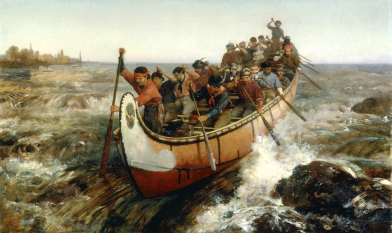Module 7
1. Module 7
1.18. Lesson 4
Module 7: Trigonometry
Lesson 4: Using Sines to Solve Problems
Focus

Frances Anne Hopkins/Library and Archives Canada, Acc. No. 1989-401-2
This painting, Shooting the Rapids, was completed in 1879 by the artist Francis Anne Hopkins. She married a Hudson’s Bay Company official and accompanied her husband on his travels. Hopkin’s work documents the fur trade, which marks an important period in Canada’s history.
The people who worked in the fur trade often travelled long distances by canoe. For example, a trip from Lake Athabasca to Montréal was more than 7000 km in length. On a trip like this, there were many portages to make and many dangerous rapids to paddle through.
The Montréal Canoe, of First-Nations design, used by the fur-trade workers (voyageurs), could exceed 10 m in length and 2 m in width at its widest point. These canoes were ingeniously crafted, constructed of bark, cedar splints, and pine tar, and were particularly well-suited for the job of transporting people and furs.
If you look at the painting shown, the men in the stern (back) of the canoe are riding well above those at the bow (front). Did you know that you could use the sine ratio to calculate this difference in height as the canoe tilts forward down the rapids?
Lesson Questions
In this lesson you will explore this question:
-
How is the sine ratio used to solve a variety of practical problems?
Assessment
You will complete the Lesson 4 Assignment Booklet for assessment. Download the Lesson 4 Assignment Booklet and save it in your course folder now. You will receive instructions on how to complete the Assignment Booklet later in the lesson. You will also be prompted to start working on the Unit 3 Project.
You will receive instructions on how to complete the Assignment Booklet later in the lesson. You will also be prompted to start working on the Unit 3 Project.
Remember to save all of your work in your course folder.
Required Materials and Equipment
You will need your clinometer, a measuring tape, and your calculator.